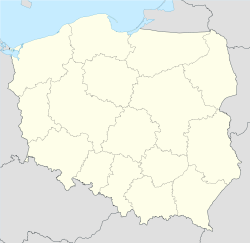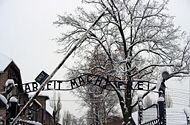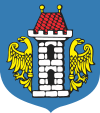Oświęcim
| Oświęcim | |||
 |
|||
|
|||
 Oświęcim
|
|||
| Coordinates: | |||
| Country | |||
|---|---|---|---|
| Voivodeship | Lesser Poland | ||
| County | Oświęcim County | ||
| Gmina | Oświęcim (urban gmina) | ||
| Established | 12th century | ||
| Town rights | 1291 | ||
| Government | |||
| - Mayor | Janusz Andrzej Marszałek | ||
| Area | |||
| - Total | 30.3 km² (11.7 sq mi) | ||
| Elevation | 230 m (755 ft) | ||
| Population (2006) | |||
| - Total | 40,979 | ||
| - Density | 1,352.4/km² (3,502.8/sq mi) | ||
| Time zone | CET (UTC+1) | ||
| - Summer (DST) | CEST (UTC+2) | ||
| Postal code | 32-600, 32-601, 32-602, 32-603, 32-606, 32-610 | ||
| Area code(s) | +48 033 | ||
| Car plates | KOS | ||
| Website: http://www.um.oswiecim.pl | |||

Oświęcim [ɔɕˈfʲeɲt͡ɕim] (![]() listen) (German: Auschwitz, Yiddish Oshpitsin אָשפּיצין, Romany: Aushvitsa, Osvyenchim, Czech: Osvětim, Slovak: Osvienčim, Russian: Освенцим) is a town in southern Poland with about 41,500 inhabitants (2005), situated some 50 kilometres (31 mi) west of Kraków in the Lesser Poland Voivodeship since 1999, previously in Bielsko-Biała Voivodeship (1975-1998).
listen) (German: Auschwitz, Yiddish Oshpitsin אָשפּיצין, Romany: Aushvitsa, Osvyenchim, Czech: Osvětim, Slovak: Osvienčim, Russian: Освенцим) is a town in southern Poland with about 41,500 inhabitants (2005), situated some 50 kilometres (31 mi) west of Kraków in the Lesser Poland Voivodeship since 1999, previously in Bielsko-Biała Voivodeship (1975-1998).
Outside Poland, it is sometimes still called Auschwitz, its German name, in reference to the Auschwitz concentration camp built there by Nazi Germany during World War II.
Contents |
History
The city was first mentioned in 1117. In 1179, it was detached from the senior Province of Kraków and attached to the Duchy of Opole. Oświęcim was organized under German law (more precisely Lwówek Rights, which was a flavor of Magdeburg Law) in 1270. Throughout history, Germans and Poles lived here together peacefully. From 1315 Oświęcim was a capital of independent duchy. In 1327, John I, Duke of Oświęcim formed with a western part of Galicia (Central Europe), the Duchy of Oświęcim, and Duchy of Zator a vassal state attached to the Kingdom of Bohemia. Later the area went again to the dukes from Te and Grossglogau. In the 14th century many people moved away. The interest of the Germans in Auschwitz shrank and in 1457 the Polish king Casimir IV bought the rights to Oświęcim which was attached afterwards the Cracow Voivodeship. Jews, invited by Polish kings to settle in the region, had already become the majority of the population in the 15th century. Oświęcim also became one of the centres of Protestant culture in Poland.
The town was destroyed by Swedish troops in 1655. When Poland was divided in the late 18th century, Oświęcim became part of the Kingdom of Galicia and Lodomeria (an Austro-Hungarian province) in 1772 and was located close to the borders of Russia and Prussia. After World War I the town returned to Poland with that country's reemergence as an independent nation. Throughout the modern era until the Holocaust, the town had been predominantly Jewish. On the eve of World War II there were about 8,000 Jews in the city, over half the population.[1]
During the German Nazi occupation of Poland, a new subdivision was built using slave labour to house the guards and staff moved to Oświęcim to run the Auschwitz concentration labor camp (Arbeitslager) and death camp. The prisoners of Auschwitz were used to build and operate the large Buna-Werke chemical works of IG Farben, which produced many different chemicals needed for Germany's war effort.
All but one of the town's twenty synagogues were destroyed by the Nazis, the exception is the Auschwitz Synagogue, now open as a museum.
Following World War II, the town recovered, and new housing complexes were developed in a typical communist style. The buildings were large, rectangular, and concrete constructions, but satisfying the desperate dwelling needs of many new town's inhabitants. Until 1989, the town thrived from the large chemical works, but in the mid-1990s, the works, renamed Dwory S.A., began to downsize and lay off its workers. During the communist era, they employed about 10,000 people. Following their restructuring and financial problems after 1989, employment at the plant shrank to only 1,500 people.
During the Second World War

In 1940 the German occupiers built the Auschwitz concentration camp by converting the Polish military barracks. Later, they also built the vast Auschwitz II (Birkenau) camp in the nearby village of Brzezinka.
It has been estimated that between 1940 and 1945 1.1 million people, mostly Jews, were killed by the Nazis in the Auschwitz-Birkenau camps.[2] (See also the articles on Auschwitz concentration camp, List of subcamps of Auschwitz, Holocaust and extermination camp for a detailed account.)
After the Second World War
After the war, the Polish government took possession of the large Buna-Werke chemical works owned by IG Farben, which had previously used Auschwitz prisoners as a slave labor. The chemical industry became the main employer of Oświęcim. In the later years, also a service industry and trade were added. The concentration camp became a museum and memorial sites. Currently, about 1 million visitors tour Auschwitz-Birkenau labor/death camps every year.
Politics
Oświęcim-Wadowice constituency
Members of Parliament (Sejm) elected from this constituency
- Janusz Chwierut, PO
- Paweł Graś, PO
- Paweł Kowal, PiS
- Marek Jerzy Łatas, PiS
- Leszek Murzyn, LPR
- Marek Polak, PiS
- Stanisław Rydzoń, SLD-UP
- Beata Szydło, PiS
People
- Łukasz Górnicki, (1527-1603) Polish poet
- Simon Syrenius, (1540-1611) Jagiellonian University professor, botanist
- Tadeusz Makowski, (1882-1932) Polish painter
- Aaron Miller (cantor), rebbe, the father of chazzan Benzion Miller
- Arkadiusz Skrzypaszek (1968) modern pentathlete
- Paweł Korzeniowski, (1985) swimmer
Sports
- The ice hockey team of Oświęcim was repeatedly Polish champions.
- Many Polish figure skaters, including the pair Dorota Zagórska and Mariusz Siudek, Sabina Wojtala, Anna Jurkiewicz and others, hail from the town of Oświęcim.
Twinned cities
Since 1993, Oświęcim has been twinned with the city of Kerpen in Germany.[3]
See also
- List of Polish Martyrology sites
External links
- Oświęcim; Auschwitz Memorial Book--Translation of Sefer Oshpitsin
- Database of pre-war Jews from Oświęcim
References
- ↑ ספר אושפיצין (Sefer Oshpitzin--Oświęcim Memorial Book, Hebrew, published in Israel by the Oświęcim Descendant and Survivor Association)
- ↑ Piper, Franciszek; review of Meyer, Fritjof. "Die Zahl der Opfer von Auschwitz. Neue Erkentnisse durch neue Archivfunde", Osteuropa, 52, Jg., 5/2002, pp. 631-641.
- ↑ Chronologic History of Oswiecim
|
|||||||
|
||||||||||



